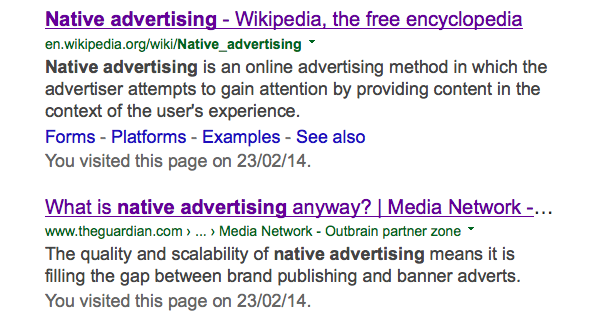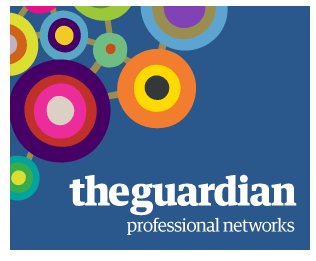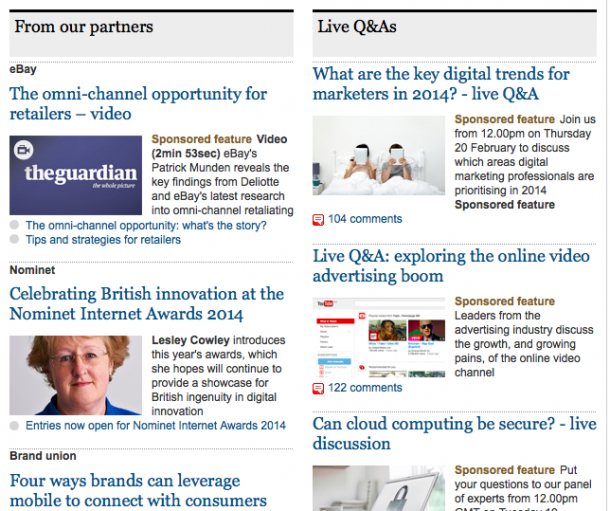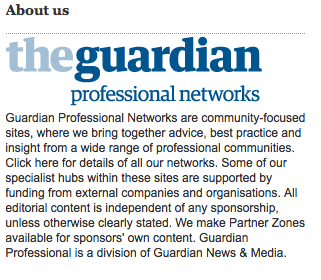When something new comes along, it can take marketers months or even years to figure out how to ruin it.
In the new world of digital and social media, we’ve finally caught up.
The new thing to come along is nothing less than the entirely new relationship between content creator and content consumer.
And our new way of ruining it is called Native Advertising.
What the hell is native advertising?
Native advertising is a way of getting around people’s natural aversion to advertising by disguising it as editorial or social content.
There are many other definitions but that’s the bottom line.
Online banner ads no longer work.
This has sent publishers into a blind panic.
At the same time, social media channels, in an effort to justify their mesospheric valuations, are turning to native advertising to ‘monetise’ their audiences (you and me).
The result? It starts with sponsored tweets and posts but soon extends to marketing content disguised as editorial and packaged up into ‘Partner Zones’ , ‘Premium Hubs’ and ‘Recommended Content’.
Hasn’t this been around forever?
Yes, it has. It was called ‘advertorial’. But it used to be well-signaled as advertorial, so you could ignore it without fearing you might be missing something good.
Today, it’s often slipped into your stream or smuggled under your cursor in disguise.
Which is why it works.
And why it won’t just fail, it’ll also take down some very valuable things with it.
Why is the native advertising trend so dangerous?
Because it sells the single most valuable commodity in all commerce – and the most valuable thing any publisher has ever had.
It sells our trust.
And it sells it cheap.
A real-world example.
I’ve been increasingly bothered by the blurring of the lines between advertising and editorial lately.
So, in an effort to learn more, I Googled the term, “Native Advertising”.
These were the top two results – just under the sponsored results (which are themselves an example of native advertising):
The first is by Wikipedia – always one of my first go-to sources on any topic.
Why? Because it doesn’t take advertising. Jimmy Wales may never be as rich as the guys who sold Tumblr to Yahoo, but he’s got something far better: integrity.
The second listing is by the Guardian.
Great. I trust the Guardian. I get it at home. Let’s see what they have to say about native advertising.
I click through and find myself on theguardian.com.
I start reading the article, “What is native advertising anyway?”.
Seems like a reasonable enough piece…
But, halfway through, I notice that this is a rather one-sided view of native advertising. Nothing about the controversial nature of the technique. Nothing about the ethical implications.
And I start to wonder if I’m really on the Guardian.
It looks like the Guardian and feels like the Guardian.
But then I notice, I’m actually in something called the Media Network Partner Zone.
What the hell is that?
Turns out this zone is a collection of content sponsored by… Outbrain.
A provider of native advertising solutions.
And the article I’ve been reading was written by Tony Hallet (via something called Guardian Professional Networks)
I click through to find that Tony Hallet is from Collective Content… an agency.
Now I realise I’ve been reading an article by an agency on a channel sponsored by a vendor – about a topic that both the vendor and agency have a vested interest in spinning.
Not the neutral, third-party evaluation I expected from my trusted news source.
An advertorial inside an advertorial… in editorial clothes.
Now I’m intrigued.
I click through to one of the many ‘Guardian Professional Networks’ – the Digital Media Network…
…and, again, I arrive at something that looks and feels like Guardian editorial.
It’s a busy page packed with what looks like Guardian content.
And some of it is (I think).
But a lot of it isn’t.
There’s a list of ‘Hubs‘ down the right-hand side, many of which are sponsored.
I click on the Advertising Hub – and arrive at the ‘Advertising Media Network‘. It doesn’t look sponsored yet, so I think I’m finally free of marketing disguised as editorial.
But I click on the lead article: ‘Viewability: a client marketer’s guide‘ – and now I’m reading something in the ‘Agencies Hub‘ supported by the Marketing Agencies Association. The article is by Kirsten Miller, from Maxus, a media agency.
Weird. I thought I had escaped the sponsored and ‘contributed’ stuff.
I go back to the Digital Media Network – that busy, editorial-packed page – and discover more content that is not really editorial at all:
The ‘From our partners‘ section (above left) lists content from eBay, Nominet, Brand Union, Adobe, Microsoft and Outbrain — all of which looks almost exactly like all the other editorial on the page (except that it’s in a section under that tiny bit of text: ‘From our partners’).
I keep exploring, desperate to find something not paid for.
How about the ‘Live Q&As‘ section (above right) – another stack of content on things like digital trends and cloud computing. These are each marked ‘sponsored content’ if you care to notice – but they don’t look like sponsored content. They look like Guardian content.
REMEMBER:
I started this with a Google search, in an attempt to get an answer to my question, ‘What is native advertising?’
I picked the Guardian as my trusted source.
And all I got was a stack of marketing content disguised (sometimes successfully, sometimes not) as editorial.
And remember:
I’m in marketing.
I’m way more media savvy than the average reader.
And a lot of this stuff fooled me.
So where does this leave me?
Here’s where:
When I started my search, I trusted the Guardian.
Now I don’t.
And where does that leave the Guardian?
In a very bad place.
Trust for sale.
Like every other newspaper in the world, The Guardian is under enormous pressure.
I get that.
But I don’t get that The Guardian has failed to see the consequences of intentionally blurring the lines between their real product – their independent analysis and judgement – and this fake stuff they’re peddling under the same masthead.
It took The Guardian more than a hundred years to earn the trust of its readers. But it’s willing – no, eager – to sell this, it’s most precious asset, to any brand with a budget. And they’re far from alone.
Marketers: come and get it.
My advice to marketers: come and get it while the getting’s good.
Some of the world’s best media brands – from the New York Time to Forbes to the best trade publications in every industry – are selling off their trust assets.
Now is the time to harness that trust to get people to your content.
Grab it before readers figure it out and the whole thing collapses.
(Of course, if YOU betray it with dishonest content, you’ll pay the price).
Readers: caveat lector
My advice to readers: be very careful out there.
The information sources you’ve trusted the most are betraying that trust.
How you know you’re in sleaze territory: a reader’s guide
The native advertising industry thrives on blurred lines between editorial and marketing. So it can be hard to know what’s kosher and what’s not.
Here’s are some of the signs that you’ve been sold out:
- Weasel words to try to disguise the source of the content – like ‘from our partners’ or ‘suggested post’ or ‘X hub’ or ‘Y zone’
- A labyrinth of layers – so you never know if you’re on a sponsored hub or a real page.
- Pseudo-editorial headlines and tone of voice – matching the site’s actual content
- Smaller and more subtle sponsorship indicators – if there are any at all
- False transparency – in most cases, you’ll be able to discover the small-type disclosure (though not always). This lets publisher plead transparency while practicing opacity (see below).
When you find yourself on a site that uses these techniques, ask yourself why you’re there and whether you’re really getting what you came for.
Where all this is going.
This can’t end well.
You don’t just sacrifice the trust of your customers and expect to maintain a healthy business.
There may not be an almighty backlash – as there should.
But there will be serious erosion of trust that will damage the media that marketing depends on.
This will create a gap in the market for information sources that refuse to sell their souls.
Honest journalism will be back.
And the gate-keepers, mediators and quality arbiters that are so out of fashion today will again be all the rage.
We need them.
Because they protect us.
From us.
———————–
For further discussion:
Isn’t all content marketing guilty of exactly this duplicity?
Why shouldn’t media players use their skills and audiences to become ‘content marketing platforms’?
Wasn’t editorial always compromised by taking advertising?
Five months after writing this post, John Oliver attacked Native Advertising in this very funny piece:

Enjoyed this article?
Take part in the discussion













Comments
Ryan Skinner February 24th, 2014
Nice piece, Doug.
Your call was about the same as mine: Marketers, jump on this and execute well. Publishers, proceed with utmost caution.
This change is being driven by the worst kind of forces – collapsing revenue from a dying business model; it’s definitely not being driven by consumers, and not by marketers and least of all by publishers themselves.
Everyone’s having to learn how to operate way outside their comfort zones. For at least a couple years, it will all look haphazard.
Doug Kessler February 24th, 2014
Totally agree, Ryan.
Loved your blog post on this, BTW:
http://blogs.forrester.com/ryan_skinner/14-01-17-native_advertising_worth_pursuing
It’s a very grey area.
It’s exciting on one side but scary as hell on the other…
My worry: by the time publishers recognise what’s at stake, it will be too late for them.
Louise Bateman February 24th, 2014
We are an online B2B publication focusing on the green economy/sustainability community in the UK, so trust and transparency are very important to us. We are currently testing/piloting native advertising and the verdict is still very much out on whether we will continue with it. However, our view is that it as long as its clearly labelled as promotional it is no different to carrying advertorials as was the norm in the old days of print publishing. Its just the digital advertising community have had to find a new buzzword for it! B2B publications have always relied for some of their revenues on sponsored and advertorial content and this content is often valuable in its own right – just as the content you advise your clients to invest in is valuable to their customers/audiences!
Consumer publications such as the Guardian are just coming to this as they try and find new ways to combat falling advertising revenues.
It’s interesting that as a content marketing experts you are taking an opposing view to native advertising.
BTW, we provide content marketing services to businesses in the green economy through our sister content marketing agency Wise Up Media.
Doug Kessler February 24th, 2014
Hi Louise
I do think it’s a grey area. But if I were a publisher, I’d be careful.
Clear signalling may be enough in your case.
In the Guardian’s the editorial is so woven in with the marketing content that I left feeling deliberately misled.
As a marketer, I see the value.
As a reader, I’m very suspicious.
And I think publishers need to know the downside as well as the clear upside.
Thanks for your comment and do let us know how you get on.
Gerry Marychurch February 24th, 2014
Hi Doug!
You got me scrambling for the dictionary again but I do like your use of ‘mesospheric’. Nice.
Is the issue really one of how well disguised the advertorial is? What is your opinion of Monocle? Isn’t their whole model based on sponsored content disguised as content? Not that you can compare a lifestyle magazine to a serious newspaper like the Guardian but…
Gerry February 24th, 2014
I think I should have said ‘disguised as editorial’ ^^^^^
Doug Kessler February 25th, 2014
Hi Gerry. Stratospheric didn’t seem quite high enough…
I do think it’s all about the disguise — and the clear separation of church and state.
I don’t mind reading brand-supplied content. Some of the best insights can come from brands.
But I never want to be in doubt about the source of my information.
Because every brand has an agenda other than giving me the independent analysis of a given issue.
Journalism was built on this.
Mary Shabestari March 1st, 2014
Great post Doug. I come from an “old school” communications background where there was a clear separation between journalism content and advertorials. Sadly one cannot trust content anywhere. This started with the cable news channels that are now so slanted one way or another. I’m amazed at the explosion of native advertising in the past couple of years. As you mentioned the failure of banner ads and conventional advertising no longer working, the push is on to use content marketing and to “inform” consumers. This contributes to the noise that caused us to all tune out the banner ads in the first place. Like you said, it’s only a matter of time before people begin tuning out native and social media advertising (another hot outlet today) Eventually the trustworthy content sources with the gatekeepers will rise to the top. I see this happening already in publishing. A couple of years ago writers were told “you can get your book published. Do self publishing – you don’t have to go the traditional publishing route.” Well now we are overwhelmed with mediocre self published content and the platform is getting a bad reputation, while being published the traditional way has retained its credibility.
Doug Kessler March 2nd, 2014
I agree, Mary. A hell of a lot has been gained when the barriers to an audience were lowered. But a lot is being lost, too.
I thought journalistic integrity wouldn’t go without a fight.
It looks like it’s just slinking away.
Alessio March 17th, 2014
I’m a big fan and reader of Monocle. Native advertising is used a lot on Monocle magazine, and I guess somehow they think it’s a good way to have sponsors but at the same time they are not interrupting the readers experience.
Well, they are interrupting. Native advertising is always advertising. Period. If I’m seeing in the middle of pages where they are talking about craftsmen in Naples a 2-pages article with the title “samsung for monocle”, I don’t read it (first) and I’m extremely disappointed because the magazine is interrupting me and it’s playing with my trust.
My first thought is always: are you kidding me? do you really think I’m going to read your ad just because it’s in the same format of the rest of the magazine, with nice photos and all? and moreover, even if I’m reading it because I didn’t notice the ad, at the end of it I’ll be pissed because I wasted time reading an ad anyway.
So I think context is what matters. If you put something about the new Honda in a magazine where they are talking about foulard, you have serious problems in your marketing team.
nice reading Doug!
Doug Kessler March 18th, 2014
Thanks for the comment Alessio.
Yeah, native always leaves a bad taste in my mouth.
I feel deceived into engaging with something I wouldn’t engage with if it was clearly labelled,
Stephen Daniels March 26th, 2014
Hi Doug,
Really enjoyed your post. The media world lost my trust a long time ago (and as you put it so eloquently “I’m way more media savvy than the average reader.”).
In my opinion the media (in it’s entirety) stopped being trustworthy a long time ago – you can’t watch the BBC news without seeing some half baked story being flouted by some pseudo expert (who’s employed by someone with something to sell).
the mainstream media is currently undergoing it’s radical transformation, and personally I can’t wait to reach the other side, where news is news and promotion is promotion!
As a marketer I don’t want my “stories” / articles to be confused with news – on the flipside, I don’t intend to get left behind – it’s a really tough balancing act.
Doug Kessler March 28th, 2014
It is a tough one, Stephen.
I guess you’re right: the media has lost credibility anyway.
Might as well take the next step and sell the shop.
Being over 50, I still have a romantic notion that the editorial side needs to protect its integrity to really serve the reader. Old-fashioned or what?
I do think this old-school editorial integrity will come back when readers start getting sick of hidden brand agendas. I hope so anyway.
Matt Jackson May 10th, 2014
Native advertising is everywhere you turn.
As well as the Guardian, there’s Forbes and the NY Times – it does feel horribly crass in some cases, but the Guardian (shock) and Nielsen conducted a survey that shows 70% of people believe native advertising is innovative, while 55% think it’s fun.
I don’t really get the fun description, but as a reader, and writer, I have to say that the ads are sometimes the best written pieces on a website.
As a marketer, it’s virtually impossible to ignore the potential it offers.
As somebody that has written quite a lot of content, following some quite questionable client specs, I gave up believing what I read a long time ago.
Doug Kessler May 10th, 2014
Yeah, it is everywhere, Matt. And the real pioneers are the ones you’d expect to be the last to fall: newspapers that were built on serving the reader first and the advertiser a distant second.
Times got tough. The distant second has zipped past and become the top priority.
Now I don’t know where to go for news I can trust.